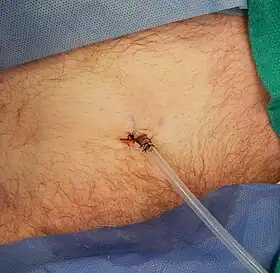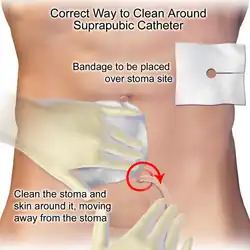Suprapubic cystostomy
A suprapubic cystostomy or suprapubic catheter (SPC)[1] (also known as a vesicostomy or epicystostomy) is a surgically created connection between the urinary bladder and the skin used to drain urine from the bladder in individuals with obstruction of normal urinary flow. The connection does not go through the abdominal cavity.
| Suprapubic cystostomy | |
|---|---|
 A newly placed suprapubic catheter entering the abdomen just above the pubic bone | |
| Other names | Suprapubic catheter |
| ICD-9-CM | V55.5, 57.17, 57.18 |
| MeSH | D003559 |
Urinary flow may be blocked by swelling of the prostate (benign prostatic hypertrophy), traumatic disruption of the urethra, congenital defects of the urinary tract, or by obstructions such as kidney stones passed into the urethra, and cancer. It is also a common treatment used among spinal cord injury patients who are unable or unwilling to use intermittent catheterization to empty the bladder, and cannot otherwise void due to detrusor sphincter dyssynergia.
Initially, a thin tube (catheter) is placed through the skin just above the pubic bone into the bladder, often with the assistance of ultrasound imaging.[2] This catheter initially remains in place for up to a month while the tissue around it scars and forms a tract (sinus) between the bladder and the body exterior. After the formation of scar tissue is complete, the catheter is replaced periodically in order to help prevent infection.
Medical uses
- Failed urethral catheter,
- Long term usage (if left in urethral long terms catheters can lead to acquired hypospadias and recurrent/chronic UTIs, urinary tract infections).
 Various settings of a 6 French pigtail catheter with locking string, obturator (also called stiffening cannula) and puncture needle.
Various settings of a 6 French pigtail catheter with locking string, obturator (also called stiffening cannula) and puncture needle.
A. Overview
B. Both obturator and puncture needle engaged.
C. Puncture needle retracted. Obturator engaged.
D. Both obturator and puncture needle retracted.
E. Locking string is pulled (bottom center) and then wrapped and attach to the superficial end of the catheter. Illustration depicting the correct way to secure the tubing and leg bag of a suprapubic catheter on a male.
Illustration depicting the correct way to secure the tubing and leg bag of a suprapubic catheter on a male. Illustration depicting the correct placement of a suprapubic catheter on a female.
Illustration depicting the correct placement of a suprapubic catheter on a female. Illustration depicting the proper way to clean around a suprapubic catheter.
Illustration depicting the proper way to clean around a suprapubic catheter.
Contraindications
- Need to rule out bladder cancer in cases of clot retention
- Lower abdominal incisions with likelihood of adhesions
- Pelvic fracture
Complications
- UTIs
- Blockage
- Bladder stones[3]
- Bladder cancer
- Bypass track by urine
Society and culture
The "suprapubic cystotomy" is a specialty of the fictional physician Stephen Maturin in Patrick O'Brian's twenty-one volume series on the Royal Navy during the Napoleonic era.[4] In modern medical terminology, "cystotomy" without the "s" refers to any surgical incision or puncture into the bladder, such as to remove urinary calculi or to perform tissue repair and reconstruction. "Cystostomy" is surgery specifically to provide drainage.[5]
See also
- List of surgeries by type
- Bonanno catheter, originally designed for suprapubic cystostomy
References
- acronyms.thefreedictionary.com.
- Jacob, P; Rai, BP; Todd, AW (September 2012). "Suprapubic catheter insertion using an ultrasound-guided technique and literature review". BJU International. 110 (6): 779–84. doi:10.1111/j.1464-410X.2011.10882.x. PMID 22257272. S2CID 6901168.
- Suzanne C. Smeltzer (2010). Brunner & Suddarth's textbook of medical-surgical nursing (12th ed.). Philadelphia: Wolters Kluwer Health/Lippincott Williams & Wilkins. p. 1373. ISBN 9780781785891.
- O'Brian, Patrick (1998). The Hundred Days (Aubrey/Maturin Series). New York: W.W. Norton & Company. p. 47. ISBN 0-393-31979-2.
- "National Library of Medicine - Medical Subject Headings".